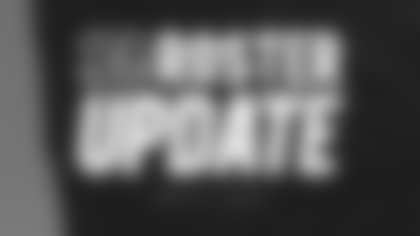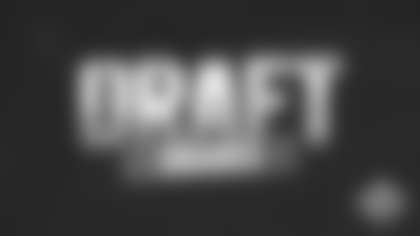The Bengals head into the last week of preparations looking to duplicate their biggest impact draft in history.
The rookie seasons the class of 2010 churned out on both sides of the ball out of the first four rounds were historic. It was anchored by the 52 catches from first-rounder Jermaine Gresham and third-rounder Jordan Shipley that led all AFC rookies and spiced by the flash of second-rounder Carlos Dunlap and the dogged work ethic of fourth-rounder Geno Atkins. Shipley, a wide receiver from Texas, also led AFC rookies with 600 receiving yards while Dunlap led NFL rookie defensive ends with 9.5 sacks and Atkins and was second among AFC rookie defensive tackles with three sacks.
"Good scouting; make that thorough scouting," says Gil Brandt, NFL.com's ageless draft analyst that helped build the Cowboys of the '60s and '70s. "They did a little bit of everything. They rolled the dice a little bit with Dunlap and they hit. They went for the top guy in Gresham and the production guy in Shipley, and Atkins had to be the strongest guy at Georgia. Yeah, I'd give it an A for a draft."
The process was pretty much how it's been since head coach Marvin Lewis arrived in 2003 and what the Bengals are doing now as the draft looms Thursday, Friday and Saturday. Bengals president Mike Brown seeks a consensus from a team effort of scouts and coaches that provides a roadmap for him and Lewis.
The scouts hammered out their reports during the fall of campus visits and film work and briefed the coaches before they saw the prospects for the first time at the scouting combine in February. In the two months between the combine and the draft, each coach went on the road to work out some of the key players and put them through the paces they needed to see them fulfill. They also tapped into their network of peers in the college game for more information while the scouts cross-checked other regions than their own.
That left Brown and Lewis to synthesize the input supplied by both personnel coaches with Brown moderating the 10 days or so of draft meetings that built the board with player rankings. Also part of the process was Lewis' daily meetings with Brown.
A look back behind the picks:
FIRST ROUND, 21st pick: TE JERMAINE GRESHAM, OKLAHOMA, NO. 18
That's how Gresham's name appeared on the card the Bengals put on their draft board, along with the key stats in shorthand. Height, weight, 40-yard dash time, Wonderlic score, arm length, body fat.
But long before that, he was on the mind of Bengals tight ends coach Jon Hayes since he once coached the Oklahoma tight ends before he came to Cincinnati eight years ago. Hayes met Gresham when he was at Oklahoma's Pro Day at the end of Gresham's freshman year when Sooners head coach Bob Stoops made sure he saw what a pro looked and sounded like.
Director of player personnel Duke Tobin, who covers the southwest, filed reports on Gresham even though Gresham missed his senior year with a knee injury because the scouts keep an eye on the up-and-comers in their region and not just those coming out into the draft. Tobin also belongs to the NFL's advisory board that counsels players before the draft on where they might be selected and since Gresham had applied to the group the year before, Tobin was more than familiar with him.
Even though Gresham was shelved for the season, Tobin continued to interview people that knew him and expanded his tape study to every game from the 2008 season, but the report was pretty much what he had at the end of the '08 season.
So there was only one real question to answer.
"He didn't play that last year. He missed a whole year. How was the knee and how did the year off impact him?" Hayes says. "He was able to work at the combine and that was a big plus for him. And I was able to work him out down there and push on him and find out how strong he was and I was able to come back and say the knee was good. It helped that I know that staff so well. The guy that coached him, the guy that recruited him. The staff people that were around him."
Gresham took one of the club's allotted 30 pre-draft prospect visits to Paul Brown Stadium, but this one was unusual. Knowing that he has simple tastes and a no-frills approach to everything but football, Hayes had Gresham to his house for dinner instead of the standard itinerary that invariably features a downtown restaurant. Jackson, Hayes' grade-school son, ended up knocking out Gresham in a Wii boxing match.
"He was relaxed when he came into the stadium the next day and I think that helped him," Hayes says. "We do with him what we do with every guy that visits and put him up on the board. I had to go back and get tape of the year before, but I was asking him, 'What's this play? What's that formation? What was the call? What were you supposed to do?' "
Gresham's best answer to one of the questions may have been, "Coach, I don't know." Hayes had just been through a similar meeting with another prospect and instead of telling Hayes he didn't know the answer, the player tried to fake it, which Hayes found off-putting.
"If you tell me you don't know," he says, "I can help you. Now I know what I need to help you."
But Gresham got a lot of it and what he didn't get, the Bengals had seen enough to know that he would do whatever he could to figure it out. Not only did Hayes watch him, but offensive line coach Paul Alexander and running backs coach Jim Anderson also offered their combined 40 years of NFL Draft experience. Plus, Lewis is always huge looming over the process.
"Trust me, Marvin is always down there in his office watching plenty of film on these guys," Hayes says.
With the Bengals playoff run cut short by their unsteady passing game, a pass-catching tight end was a high priority and they were picking in a spot where those guys usually start coming off the board. Gresham netted the highest grade by a tight end on their board on the strength of reports from Tobin and Hayes, but here's the key difference between last year's draft and this one:
With free agency steaming through its second month as the draft neared, the Bengals had a good idea at this time last year of what other teams needed. They were confident that Gresham would be there and if someone picked him before 21, then Arizona's Rob Gronkowski would certainly be there.
(If not, Hayes had also made trips to see second- and third-rounders. But not Miami's Aaron Hernandez, who didn't fit the Bengals specs for blocking and who fell into their category of a slot receiver.)
There was no surprise when Hayes called to tell Gresham the Bengals had taken him. He was by himself watching the draft in his Norman apartment.
"He just told me, 'Coach, I'm ready to go to work.' That's him," Hayes says. "He's such a gym rat; I figured I'd better remind him to bring a suit."
Gresham brought one for his introductory news conference the next day, but it got lost on the plane. With the help of veteran tackle Anthony Collins' borrowed tie, no one noticed and he's kept up with the great first impressions.
"They never found the suit," Hayes says.
But the Bengals certainly found a tight end.
SECOND ROUND, 54th pick: DE CARLOS DUNLAP, FLORIDA, NO. 8
Defensive coordinator Mike Zimmer admits this might not be the right pick this year. Dunlap had a DUI and some questions about his approach to the game coming out after his junior year. "He liked to do things his way," Zimmer says.
But last spring the defense was coming off a No. 5 ranking and was the centerpiece of a division title with some players who had been criticized for attitude in a previous life.
Veteran defensive tackle Tank Johnson refuted the critics by meshing well enough to earn a long-term deal, but the pick that probably led to this one more than anything was the 2009 selection of Georgia Tech defensive end Michael Johnson in the third round.
Johnson wasn't supposed to finish plays and supposedly lacked intensity. It turned out he was everything but and now forms one of the NFL's most exciting young pass-rush tandems with Dunlap.
"I was probably getting a little cocky," Zimmer says. "We had gotten a lot out of Tank, and Michael came in and did well for us. We said we can get these guys to play. This might not be a good year to do that, but that's all a big part of what you do. It's where you are and what kind of people you have around him. We thought we had a good enough nucleus to take him. The guy's got a lot of potential. But those are the coach killers. They get you fired."
Bill Tobin, the Bengals southeast scout who has been involved in picking five Hall of Famers, had enough in his report to whet Zimmer's appetite. At 6-5, 277 pounds, Dunlap had first-round explosion. And he had a big enough frame that he could put on 20 more pounds or so and eventually be able to slide inside at tackle now and then. Defensive line coach Jay Hayes had already caught Dunlap's act on TV as a sophomore when he was named Defensive MVP of the Gators win over Oklahoma in the national title game.
"He flashed on film; very similar to what he did when he got here," Hayes says.
And that's exactly what Hayes goes by: the film. He didn't go to the Pro Day for either Dunlap or Atkins. Although Hayes was at other Pro Days, one of the changes Lewis brought to the process was cutting back on the number of scouting trips by coaches.
"The most important thing is studying the film; that's the true test of what guys are in my opinion," Hayes says. "It's the same thing with a transcript. That's what they actually did."
The research showed the DUI was a one-time incident the Bengals felt was the exception rather than the rule. Hayes talked to Dunlap at the combine and when he visited before the draft and was able to hit it off with him.
"His mother is an educator and my mother was an educator and my father was supervisor for a parole board and his father is a bounty hunter. We can relate to each other in those terms," says Hayes, who knew the questions about Dunlap's motor. "It was hot and cold. Just like any young kid. He showed he had talent. He showed he ran to the ball most of the time. He's like a lot of young kids."
How young? The week of the combine Dunlap turned 21.
Like his brother Jon, Jay Hayes is a former college coach with contacts throughout the country and Gainesville is no different. He knows several people on the staff and it helped that then-Florida head coach Urban Meyer is friendly with Lewis. Zimmer relied on Hayes to get a feel for Dunlap because he didn't talk to him.
"The position coaches know these guys better than me. I usually take the top guys and start looking through them, or they give me guys to look at," Zimmer says. "I know who the top guys are from the combine and draft grades but I try not to look at grades and I try not to look at 40 times until after I watch the tape. If watch the tape and he runs a 4.8, I don't worry about it. But if he ran a 4.4 and I like him on tape … ."
Zimmer may not have talked to Dunlap, but he talked to plenty of those around him and he kept in touch with Hayes about him and other prospects. "We talk all the time," he says. And there was the film, where Hayes noted the positives and negatives.
"He had a tendency to spin when he got in trouble," Hayes says. "I understood why he was doing it. He was trying to get out of the double team, but that was always his answer and that's not always good."
After the first round that Thursday night, the draft room stayed to re-sort the board for Friday's second and third rounds. Dunlap was high on the list, but he was still there late in the second at No. 54. He was by far the best player on the Bengals board, so the discussion as their pick neared got smaller and smaller. Brown guides the discussion, asking the relevant coaches and scouts for their input.
"Everybody starts jockeying," Hayes says.
The position coaches, unlike many teams, hold a lot of sway with Brown but he's also listening to scouts, the coordinators, and Lewis.
"I think they hear us loud and clear," says Jonathan Hayes of the position coaches. "And the thing that happens here that is different than other places is not only is it given serious consideration, but you are also saying how they would fit and be used. That helps us get a feel."
But in this case, Dunlap was rated so high there was little debate.
"We ended up rating him higher than he went; it was a good value as far as talent," Jay Hayes says.
That's a big part of the Bengals philosophy. If the need isn't great, but the grade is clearly superior to what's on the board, that pick is going to help at some point.
A similar pick? The second-round in 2006 when the Bengals were on the verge of re-signing their Pro Bowl tackles and they still took LSU's Andrew Whitworth, their highest-rated guy at No. 55. Five years later injuries have made him the bulwark of the line, not to mention the locker room.
Who knows where Dunlap can go after getting 9.5 sacks and he didn't start playing until November? Zimmer has a few thoughts there.
"I keep seeing where we're dumb for not playing him until then," Zimmer says. "We knew he could play and that he was a good athlete. That's not why he wasn't playing. You have to earn it to play and for those first eight weeks he didn't earn it. And there's a little to be said about just because a guy walks through the door you don't hand him a job. There are 52 other guys on the team watching and saying, 'This guy's doing nothing and he's playing, maybe I don't have to be doing anything, either.' You have to do what's best for the team. But this stuff he would have had 20 sacks … believe me, I saw him at the beginning."
But, as both Hayes and Zimmer say, "He's listening. He's getting better, he's doing a good job, and he just has to keep with it."
"You've got to remember," Hayes says. "He's still a young guy. He would have just been getting out of college right now."
THIRD ROUND, 84th pick: WR JORDAN SHIPLEY, TEXAS, NO. 8.
If there was a guy that the Bengals wanted a year ago at this time other than Gresham, it was the 6-foot, 190-pound Shipley, the most productive receiver in the history of the University of Texas. It seemed like Duke Tobin had been watching him forever, and he had because although Shipley arrived in Austin in 2004 he didn't start playing until 2006 because of injury.
A coach's son with great hands, Shipley would turn 25 at the end of the season and already looked like he was ready to step into an NFL slot. Great maturity, but the Bengals felt like his competitiveness as much as anything got him on the field early.
The Bengals liked his production at a big school and in big games. Ten catches for 122 yards in the national title game loss to Alabama as a junior and earlier that season against Oklahoma he went for 112 yards on 11 catches, and set the Texas record with 15 catches against Oklahoma State. Plus, Tobin had a good rapport with Shipley's position coach, a guy that had been on the staff when Tobin played in college. His fit with what the Bengals offense needed and how it matched his skill sets were uncanny.
Minutes after the Bengals picked him last year, receivers coach Mike Sheppard, who has since left for Jacksonville, expressed the sentiment.
"He's a consistent, solid target ... against a high level of competition," Sheppard said that night. "His strength would be inside, filling that void that maybe T.J. (Houshmandzadeh) had when he was here. ... It's just like Marvin said to everybody: Trying to give Carson (Palmer) more weapons to work with and I think we've given him certainly a productive one."
The Bengals didn't get lulled by average 40 times. Shipley's 4.5 40 at his pro day was the fastest he had run and the one thing that surprised them when he got here was that he was a little quicker than they thought. But Sheppard put more stock in the Texas secondary coach telling him that none of his players wanted to cover Shipley.
"I think (Wes) Welker is a pretty good comparison," Sheppard said that night of the Patriots Pro Bowler. "Quick. Darts around. T.J. had a little more size and probably smooth was his thing. I think they're similar in that they're both real bright and real productive and have great hands."
Footnote: After two NFL seasons, Welker had 29 catches for 434 yards with two teams before he caught 112 balls for the Patriots in his third season. Houshmandzadeh didn't catch 52 balls until his fourth season.
FOURTH ROUND, 120th pick: DT GENO ATKINS, GEORGIA, NO. 56
Zimmer smiles.
"I kind of got on the table for the guy," he says.
Coming out of the '09 season, Zimmer wasn't happy with his pass rush, particularly from the inside. Bill Tobin had a kid in his area that he made sure Zimmer would see on tape. He wasn't very tall, that's for sure. Just 6-1. But he was 290 pounds and pumped the 225-pound bench press at the combine 34 times. Jay Hayes also liked what Tobin had seen on tape and ignored the stats that took a dip his senior year.
"He's not tall, but there are guys like him that are productive players in the NFL. Just look out there on Sundays. There are guys like him out there playing with that body type," Hayes says. "Short, squatty, but he has long arms. Geno's got great strength, superior quickness and he's got decent arm length for a guy 6-1."
The intangibles were obvious to the scouts and Hayes. Terrific. Great kid. Mature. His father, Gene Atkins, played safety in the NFL for a decade and his eight-year-old son could remember that final season with Miami. He got his name from the Saints locker room where the five-year-old was tagged with "Geno" and it stuck.
Atkins reminded Hayes some of another Georgia D-lineman the Bengals took six years before in Robert Geathers, a son and nephew of NFL players.
"Both are quiet guys. Studious. They're NFL legacies," Hayes says. "Geno's right in his chair (in meetings), always ready to go. They understood coming in what a work day is like, what a practice week is like. I think that gives guys like that a big advantage and it's something you have to look at."
To Zimmer, the Atkins pick is an example of what Bill Parcells told him when Zimmer was coaching with him in Dallas.
"Don't tell me what he can't do. Tell me what he can do. Have a vision for the guy," Zimmer says. "That's what we did with Geno. I didn't care what he did against the run. I was looking for a third-down guy on pass rush. That's how we saw him and where he would fit in."
Hayes is quite familiar with the fourth round. Going into the fourth last year, two of his starters, Geathers and Domata Peko, were fourth-rounders.
"At that point in the fourth round, they come off the board funny," Hayes says. "You don't know what other teams have on their boards. We thought he would be there at around that time. At the point you're looking for a specialist-type guy, that's where you'd take a guy like that, and Geno's niche was rushing the passer. That's how Robert started out, but he later grew into an every-down role. He did more than his projection. Hopefully Geno can, too."
The key for both the scouts and coaches is that three of those top four picks were not only the best players on the board, they fit the Bengals right where they needed them.
Zimmer made his phone calls to get feedback on Atkins. He talked to a guy that used to work with him and when he asked who he thought the best pass rusher was at the Senior Bowl, he said it was Atkins. Zimmer had Tobin's reports, plus Duke Tobin had seen Atkins on tape while scouting some parts of the south.
So Zimmer says, "I planted the seed early … Mike (Brown) calls it 'putting a chip on a guy.' I put my chip on him."
If you want to get Zimmer heated, talk to him about draftnicks and ratings.
"Who cares where a guy is supposed to go?" Zimmer asks. "Just because people say you drafted a guy too high? You can't listen to the Mel Kipers of the world. If you think a guy can play and that's what your team needs and wants, then who cares what everybody else thinks?"
Atkins was among the standard clutch of players the draft room discusses as the clock ticks toward their pick. Hayes says Brown listened to him during the drafting of Geathers and Peko and he listened on Atkins.
Hayes shakes his head, too. This is a tough business.
"There were some guys I wished they hadn't listened to me," he says.
"(Brown) asks questions about this guy, that guy," Zimmer says. "I think he's a good listener and he tries to do what people want done."
Zimmer got his chip, Hayes got his man. A few minutes before Atkins made his debut in the Hall of Fame Game, Hayes pulled together Atkins and one of the men just inducted, former Vikings defensive tackle John Randle. Hayes introduced Atkins and Randle knew exactly who his father was.
"John's face lit up because he saw this squat-bodied, high-energy guy; just like him," Hayes says. "I said, 'Look Geno, this guy's in the Hall of Fame.' John was a free agent and Geno went in the fourth round. We'll see."
The compensatory picks in the third and fourth rounds, Wake Forest cornerback Brandon Ghee and Texas linebacker Roddrick Muckelroy, played minimal roles as rookies. But they'll get a chance to play more in this season of transition. And then there's the fifth-rounder out of Eastern Illinois, a guard that was on the practice squad all last year.
"Don't think Otis Hudson can't play," Brandt says.













